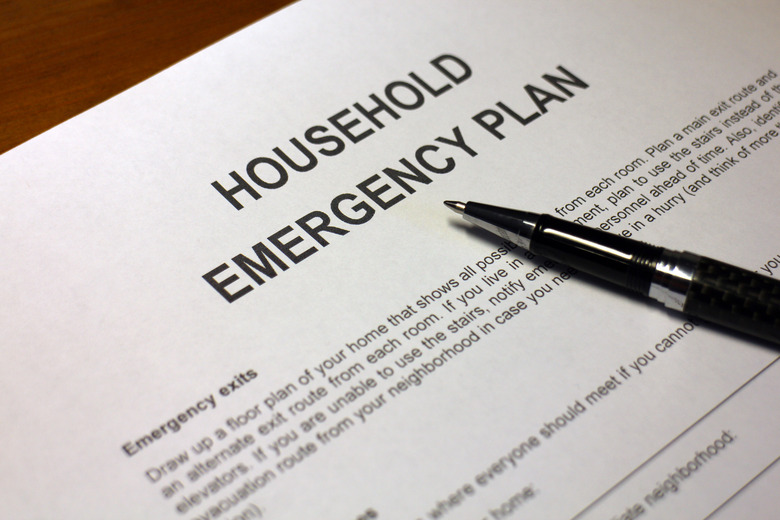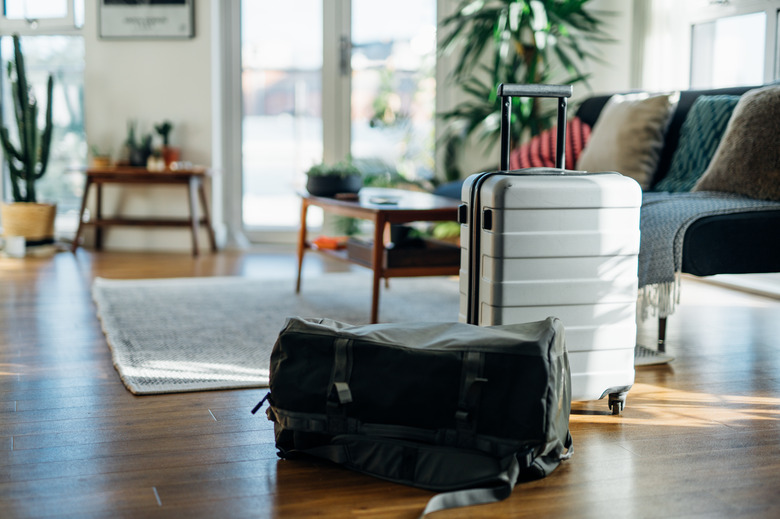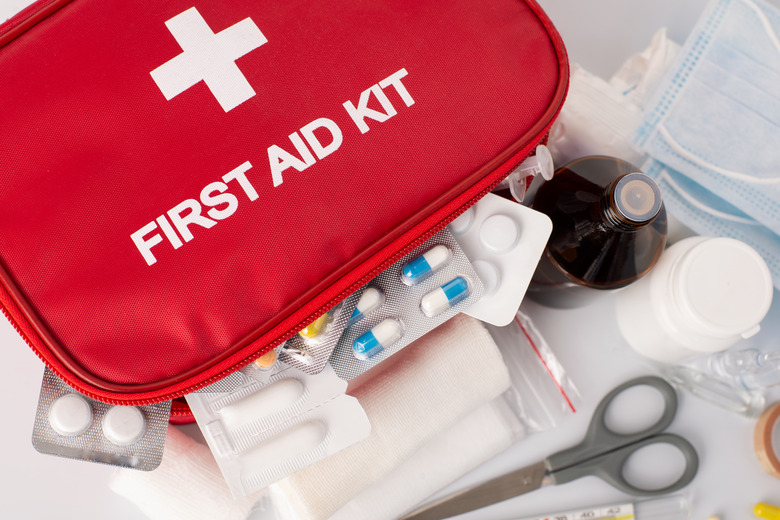Everything You Need To Know To Create A Comprehensive Family Emergency Plan
We may receive a commission on purchases made from links.
Although we don't like to think about the unthinkable, it's important to have a family emergency plan at the ready just in case disaster strikes. Even just spending a bit of time planning ahead (and procuring a few emergency supplies) can keep you and your family safe in an emergency situation — whether that be severe weather like a tornado, a hurricane or a flood or an electrical house fire.
Fortunately, when making your family emergency plan, you don't have to think of all the types of disasters and contingencies for them yourself. Doing so is almost impossible, and it turns emergency preparedness into an overly complicated process. Instead, visit a resource such as the American Red Cross to learn what natural disasters and emergencies are most common where you live. You can then prepare your family accordingly.
Know How to Make a Safe Emergency Exit
Know How to Make a Safe Emergency Exit
First and foremost, the most important thing to do in an emergency is to get your loved ones to a safe place. What that means may vary. If you live in an area with frequent tornadoes, for instance, you'll want the whole family to gather in the basement or an interior room with no windows. If flooding is more likely, your family members may best be served by looking for higher ground, such as a second story. A fire, of course, indicates that you need to leave the house and meet somewhere else.
When choosing escape routes, physically walk into each room of your house and make a plan. Make sure every member of your family knows how to quickly vacate every room in the house. Don't just assume you'll be able to make it to a back door or first-floor window. Depending on where a fire starts, for example, you may need to leave the house via the second floor (which will require an escape ladder).
Remember that "getting out" may also mean more than leaving your house. You may have to leave town altogether. In that case, plan for multiple evacuation routes to leave your neighborhood or city. Factor heavy traffic into your plans since you probably won't be evacuating alone. If emergency personnel direct you to a specific emergency route, follow it. Shortcuts and back roads are sometimes inaccessible during natural disasters.
Know Where Your Emergency Kit Is — and How to Pack It
Know Where Your Emergency Kit Is — and How to Pack It
Your family emergency plan for disaster preparedness isn't complete until you go beyond planning and start preparing an emergency kit filled with all your most important documents and some other essentials. Though everyone's emergency supply kit will look different, ensure yours includes some extra clothes, three days of water for each family member and a first-aid kit. You'll want a few nonperishable food items. If necessary, stash some of your prescription medications, some pet food and extra batteries or chargers.
It's also a good idea to grab personal care items, such as toothbrushes and toilet paper. Although it may seem like overkill, your disaster supply kit should also include a sleeping bag, matches, basic tools, duct tape, a flashlight and a can opener in case you are temporarily unhoused. Hopefully, you'll be able to evacuate to a friend's home or a well-stocked shelter if your house is damaged from a flood or a fire, but depending on where you end up, it's better if you have what you need to rough it for a few days.
You'll also want to bring as many important documents as you can. Get a fireproof lockbox and fill it with your passports, Social Security cards, immunization records, car and home titles, birth certificates and any other documents that could be difficult or expensive to replace.
It's also imperative that you place a list of important contact information in your bag or lockbox. Remember to include out-of-state relatives if you can along with the telephone numbers for any relevant children's schools, workplaces and daycare centers. Once a year, go through your list and update any numbers as needed. While you're at it, replace any expired medications or clothes the kids have outgrown. Expired medications, dead batteries and outgrown clothing won't help you, so make sure you keep your bag current.
Know Your Emergency Meet-Up Spot
Know Your Emergency Meet-Up Spot
Sometimes, families get separated during emergencies, so have a plan for that too. Pick a safe meeting place, like a neighbor's home or a local park, in case you need to evacuate your house due to a fire or other threat. It's also smart to choose a designated person with whom everyone can check in. Even if your family can't get to the designated meeting spot, checking in with a friend or family member can ensure that everyone is safe, and you can track where they are.
If you'll be evacuating with pets or someone who needs medical equipment, find an appropriate shelter or evacuation site before you need one. Not all emergency shelters take pets, and some may not have the space or access to electricity that medical devices may require. Depending on your circumstances, not every shelter will work for you. Know where you're going well before you need to get there.
Note too that if you have resisted getting your kids a cell phone, you may want to consider. During emergencies, it's much easier for people to text each other. Text messages require much less bandwidth than a phone call. This means you can often get a text through even when the phone lines get bogged down. Above all, have a communication plan: Ensure your family knows how to get in contact with each other in a variety of situations.
Know Your Part of the Family Emergency Plan
Know Your Part of the Family Emergency Plan
When drafting a family disaster plan or evacuation plan, it's good to assign members of your household a job. Assign one person the task of grabbing the lockbox containing your important documents. Another family member may be responsible for grabbing the family's emergency bag of clothes, medications and other necessities.
In some families, older children can often help get younger ones to safety. If you have an elderly or infirm family member with special needs, it's crucial to make sure someone is tasked with helping that person evacuate. Preferably, this will be the family member with the most knowledge of the person's needs and medical equipment.
Know How to Always Be Prepared
Know How to Always Be Prepared
There are two kinds of people in this world: Those who don't care when their car's fuel gauge sits at the empty mark, and others who fill up as soon as the needle moves off the full mark. At the end of the day, however, those who keep a full tank of gas fare better in emergencies. If you get in the habit of keeping your tank at least half full at all times, you won't have to worry about running out of gas while evacuating.
If you have children, make sure they know their last name and their phone number. It may also behoove you to teach them your first name. Emergency personnel have a harder time reuniting lost children with parents vaguely named "mommy" or "daddy."
When they're old enough, it's also a good idea to teach every member of your household how to turn off your utilities. Gas, water and electricity can all trigger problems of their own during a disaster. For instance, you don't want to keep your gas turned on if there is a wildfire creeping toward your house. Turning off your water can also conserve drinking water, which is often precious during an emergency.
Although not strictly necessary, it's a smart move to take first-aid and CPR classes. Hopefully, you'll never need to use the skills you learn in these courses, but it's better to know first-aid and not need it than it is to find yourself in a situation where you wish you knew how to help.
Remember too that you may not be going anywhere. A massive snowstorm, for instance, means you could be stuck at home for a few days during a shelter in place order. Make sure you have plenty of food and medication in your home and be prepared to deal with power outages in case you should find yourself in this sudden emergency.


